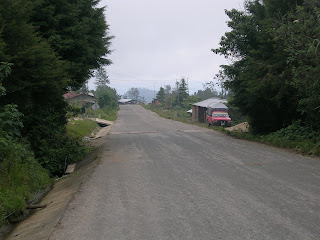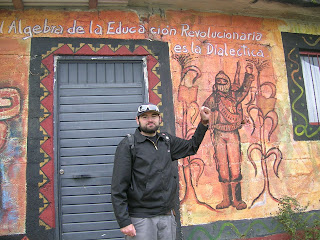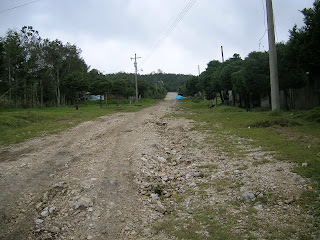You may not have heard of these guys before so here is the 411. The native people of southern Mexico were always poor and lived without many of the basic services that most of the rest of Mexico had. Most of the land is owned by rich people outside of chiapas or is foriegn owned. Leaving only the leftover land in which local people could farm corn for themselves, the area is really mountainous and is at altitude too, making farming there really hard work. Its amazing to see cornfields everywhere, especially on the side of steep hills.
Much of the resources and money that was made in chiapas was not staying in chiapas and being shared with the people who worked for it. On Jan 1st 1994 Mexico, Canada and the USA were to sign a free trade agreement.
Corn farms in the states use machinary and are massive operations, able to farm cheaply. Corn farmed in Chiapas is done by hand, on huge mountainsides and is very labour intensive. With no tariffs on imported corn American corn would be much cheaper to buy, taking away the local Mayan people's major source of income.
On that new years day, the Zapatista movement rose up, led by their leader Sub Comandante Marcos, and took over several towns and cities in Chiapas in an armed struggle. The Mexican army soon came down and took them back, but the Zapatista's had the support of much of the population and many of the small towns in the area. They were there to stand up for the indiginous population and take back what was rightfully theirs. Within a week of the first action they announced that they would not use their weapons again, instead they would use international support and media pressure to fight for their rights.
The Zapatistas all wear ski masks or bandana's over their faces to hide their identities, but also to push the idea of equality. All Zapatista's have an equal voice. Marcos even uses the title "Sub" Comandante to show that he takes his orders from the people. Today the Zapatistas control about 30 towns in Chiapas, each is run independently of the Mexican government, they have their own schools, own hospitals everything. Ovientic is one of those towns.
We got in a taxi in San Cristobel and traveled through the mountains on winding roads for about an hour. We didn't quite know what to expect and were surprised when the taxi dropped us off in the middle of nowhere.
 There were just these signs on the roadside...
There were just these signs on the roadside...
 We went to a gate and were greeted by an old woman in a ski mask who took our passports and told us to wait. We waited for a few minutes and then were led down into a small building for an interrogation with 4 or 5 guys all in disguise. After bumbling though with the little Spanish we had, we were led to this building and told to wait until we were called in.
We went to a gate and were greeted by an old woman in a ski mask who took our passports and told us to wait. We waited for a few minutes and then were led down into a small building for an interrogation with 4 or 5 guys all in disguise. After bumbling though with the little Spanish we had, we were led to this building and told to wait until we were called in. Once we went inside it was another interrogation, they asked us where we were from, what job we had, if we represented any organisation. We were really struggling with the Spanish, and it was a bit intimidating but luckily an Italian lady turned up that was able to translate for us. Once all the formalities were through he welcomed us to the town, and told us when we go back home to spread the word and tell our people about their cause. There were only 2 conditions, no photos of people without masks and no photos of cars. Should any person or car be recognised they would be arrested. This was our comrade that interviewed us.
Once we went inside it was another interrogation, they asked us where we were from, what job we had, if we represented any organisation. We were really struggling with the Spanish, and it was a bit intimidating but luckily an Italian lady turned up that was able to translate for us. Once all the formalities were through he welcomed us to the town, and told us when we go back home to spread the word and tell our people about their cause. There were only 2 conditions, no photos of people without masks and no photos of cars. Should any person or car be recognised they would be arrested. This was our comrade that interviewed us. His house was filled with awesome propaganda art, I would have loved to get a hold of some of that stuff.
His house was filled with awesome propaganda art, I would have loved to get a hold of some of that stuff.

 Even the famous mexican icon, Mary of Guadalupe is a supporter.
Even the famous mexican icon, Mary of Guadalupe is a supporter. After we left his house we were free to walk around and take photos of the town. All the buildings were painted with revolutionary images.
After we left his house we were free to walk around and take photos of the town. All the buildings were painted with revolutionary images.


 They love Che here.
They love Che here. I was loving the artwork.
I was loving the artwork. This is a picture of Marcos, he is always smoking a pipe through his ski mask.
This is a picture of Marcos, he is always smoking a pipe through his ski mask. Even the basketball court is revolutionary.
Even the basketball court is revolutionary. Despite the minor victory the Zapatista's have won in setting up their Autonomous towns, they are still very poor. This is pretty much the whole town.
Despite the minor victory the Zapatista's have won in setting up their Autonomous towns, they are still very poor. This is pretty much the whole town. The view was great, but it must be hard work to farm up there.
The view was great, but it must be hard work to farm up there.
The whole experience was great, and really stuck with the both of us. It was great to see these oppressed people so organised and fighting for what they should have already.

Getting back to town was another story, we were told to wait on the roadside until a collectivo (a kombi van that is basically like a cross between a taxi and a bus) drove by. It was getting late, and cold and we waited for nearly an hour, the clouds started to roll down.
 Just when I thought we were going to be stuck there for the night one pulled up and took us back to San Cristobel. But not before I picked up a souveneir.
Just when I thought we were going to be stuck there for the night one pulled up and took us back to San Cristobel. But not before I picked up a souveneir. Although most people in San Cristobel arn't too fond of the Zapatista's they do have allot of support. Most of the protest seems to be done using stencil graffiti. The images were all really cool.
Although most people in San Cristobel arn't too fond of the Zapatista's they do have allot of support. Most of the protest seems to be done using stencil graffiti. The images were all really cool.



 So anyways, I promise there won't be anymore political ranting on here for a while, but if you are interested learn more about the Zapatistas and spread the word.
So anyways, I promise there won't be anymore political ranting on here for a while, but if you are interested learn more about the Zapatistas and spread the word.

No comments:
Post a Comment